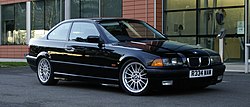Claus Luthe
Claus Johannes Luthe | |
|---|---|
| Born | December 8, 1932 |
| Spouse |
Gertrude Luthe (m. 1953–2008) |
| Children | 4 |
Claus Luthe (December 8, 1932 – March 17, 2008)[1] was a German car designer, noted for his design work on the NSU Ro 80, Volkswagen K70 and numerous seminal models from Audi and BMW. Luthe was a pioneer of aerodynamics and digital design within the automotive field.[2]
On his death in 2008, The Guardian called Luthe "one of the most important figures in postwar European car styling."[3]
Career
'"Luthe was one of the first to embrace digital tools to improve and accelerate the process so that the designers could pass information directly to the engineers in digital form, he changed the methodology of designing into what everybody does today.”[2] — Robert Cumberford
Luthe was born in 1932 in
NSU

He soon, however, joined
The Prinz had a distinct resemblance to its contemporary Chevrolet Corvair; the original design had already been finalized when BMW launched its new 700 model in 1959, with a very similar design. NSU management decided that changes were needed, and an NSU board member who had just returned from the United States described the Corvair design to Luthe, who incorporated some of the elements into the Prinz's bathtub design.[4]
With the growth of the German economy, NSU was interested in offering larger cars to the growing middle class, and in 1962 NSU president Gerd Stieler von Heydekampf authorized the development of a mid-sized front-wheel drive sedan, using the company's revolutionary new Wankel engine technology. Chief engineer Ewald Praxl was given the assignment to develop the car, originally envisaged at 800 kg and 80 hp, starting from a clean sheet.
Luthe was given responsibility for the design, working with the engineering team of Walter Froede and Georg Jungbluth, [5] to utilize the compact Wankel engine, itself created by
"After these wind tunnel tests, the outer shape of the body was not modified at all. We got, however, new insights into the airflow through the engine compartment and the possible air outlets for the passenger room. These could have been moved to the rear end of the boot, but the improvement was so marginal and the cost involved so high that these outlets remained in the C-pillar."
In late 1967, when the remarkable new Ro 80 was introduced at the

The K70 was originally created by Luthe as the NSU K70, to fill the gap between the Prinz and the Ro 80, but came to the market in 1971 as a Volkswagen K70, after considerable delays, partly due to the Volkswagen acquisition of NSU, and with modifications to Luthe's original design.
Audi

Following the takeover of NSU by Volkswagen, Luthe continued to work for Audi from 1971 to 1976. His first project at Audi was the Audi 50, on which the original Volkswagen Polo was based. Luthe completed the styling of the tidy three-door hatchback design, as well as guiding the interior design; the concept of the dashboard design is remarkably similar to that proposed by Luthe (but rejected by the NSU management) in the original Ro 80 prototypes. While the Bertone design house was consulted on the near-final design, only modifying a few small details, such as the upsweep of the chrome trim on the side. The 50 was introduced in August 1974, just three months after the debut of the Volkswagen Golf.
He subsequently designed the interior of the second-generation Audi 100 C2, and produced the initial proposals for the Audi 80 B2, although the design was modified substantially, and finalized by Giorgetto Giugiaro, after Luthe left Audi.
BMW



In 1976 Luthe succeeded
Luthe, then, was tasked with developing a facelift for the aging
The next priority was the development of a successor for the E21 3 Series. In order to broaden the appeal of the model, a four-door version was to be added. Luthe maintained a low front profile and the familiar dual round headlights in the
After the launch of the E30, BMW chairman
He then supervised the design of the
Personal life
Luthe was married with four children. He left his post at BMW after being accused of fatally stabbing his 33-year-old, chronically drug-dependent oldest son, Ulrich after an argument on Good Friday in 1990. He was eventually convicted of manslaughter and sentenced to 33 months in prison, but was released before having to serve the complete sentence.[10] He later worked as an external consultant for BMW.
See also
References
- ^ "Claus Luthe ist tot" Archived 2008-09-15 at the Wayback Machine, Stuttgarter Nachrichten, 20 March 2008
- ^ a b "Claus Luthe, Car Design Innovator, Is Dead at 75". New York Times, April 10, 2008.
- ^ a b "Claus Luthe". The Guardian, April 3, 2008.
- ^ "Gespräche mit Claus Luthe", Uit Wankel Journal, December 1996. Accessed April 20, 2008.
- ^ "1967-1977 NSU Ro 80" Archived 2008-04-23 at the Wayback Machine Auto Editors of Consumer Guide, October 29, 2007. Accessed April 20, 2008.
- ^ "Claus Luthe: Designer of the Daring Ro80" Archived 2016-03-04 at the Wayback Machine, Dexigner, April 3, 2008. Accessed April 14, 2008.
- ^ Luthe, Claus. Uit Wankel Journal, December 1996.
- ^ Kirchberg et al.: A History of Progress, p.200. Audi AG, 1996.
- ^ "Hommage an Claus Luthe" Initiative Kulturgut Mobilität, Ralf Ziegler. Accessed April 25, 2008.
- UPI, April 10, 2008, Accessed April 14, 2008.
